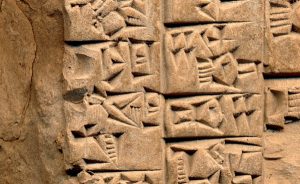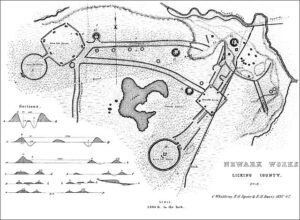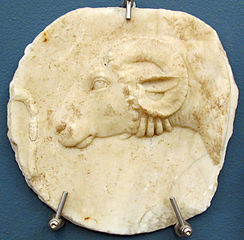Japanese-Peruvian Team Discover 168 More Nazca Lines
One hundred sixty-eight previously unrecognized Nazca Lines dating from 100 BCE to 300 CE have been identified by a Japanese-Peruvian research team in Southern Peru. The newly discovered geoglyphs – markings made by removing a top layer of dark rock to expose lighter sand below – include abstracted figures of humans and a wide variety of animals including camelids, birds, killer whales, felines, and snakes. The discovery was announced by researchers led by Professor Masato Sakai, a specialist in Andean archaeology from Yamagata University and Peruvian archaeologist Jorge Olano.

The Spider, Nasca World Heritage Site, The Spider (Nazca Lines), 30 January 2019, Photo by PsamatheM, CCA-SA 4.0 International license.
The Nazca geoglyphs were named a World Heritage Site in 1994 and their fame has attracted both tourists and protests. In 2014 Greenpeace activists laid out giant letters in a message calling for environmental action next to a major Nasca image of a hummingbird damaged the protected site, for which Greenpeace apologized.
Yamagata University has been committed to studying the glyphs in the region for some time. The university established an Institute of Nazca in the town of Nazca in 2012, and in 2015 signed an agreement with Peru’s Ministry of Culture to expand their work. In 2017, an archaeological park was established to protect glyphs located near downtown Nazca.
The team collected data in field surveys to collect high resolutions aerial and drone photographs of the Nazca plain and along ancient trails in the surrounding hills. They used AI to analyze the images to locate dozens of mostly smaller figures in locations such as across hillsides, where the lines hadn’t previously been recognized.
Syrian Cultural Admin Announce 35,000 Antiquities Recovered – Inside Syria

Cuneiform tablet from the Idlib Museum. http://cdli.ucla.edu/collections/syria/idlib_en.html@section=3.html.
Syria’s director of cultural relations and head of the professional development department at the Directorate of Antiquities and Museums announced at the end of November 2022 that some 35,000 antiquities had being recovered from inside Syria since the beginning of its decade-long civil war and conflict with ISIS extremists. Director Firas Dadoukh praised local communities for assisting in the returns. Cultural authorities at the Museum of Ancient Syrian Antiquities also credited the Syrian army with many of the confiscations and with preventing their export outside the country.
This represents a positive change from during the conflict with ISIS, when some of the most severe looting took place in areas held by the army. Reports throughout the conflict have shown that virtually every one of the factions in the Syrian war have been culpable in looting.
A 2015 study by Dr. Jesse Casana of Dartmouth University using satellite imagery found that while there was significant looting in areas controlled by ISIS, it may have been even more frequent in areas held by forces in opposition to the Assad regime and by the Kurdish People’s Protection Unit (YPG). Dr. Casana told the press that, ““Most media attention has focused on the spectacles of destruction that ISIS has orchestrated and posted online, and this has led to a widespread misunderstanding that ISIS is the main culprit when it comes to looting of archaeological sites and damage to monuments.”… “Using satellite imagery, our research is able to demonstrate that looting is actually very common across all parts of Syria, and that instances of severe, state-sanctioned looting are occurring in both ISIS-held and Syrian regime areas.”

Photo of boxes of shards taken from Idlib Museum.
In 2017, Anas Zeiden, the Idlib Museum director in the then Free Idlib Provincial Council, announced plans to file lawsuits in international courts to recover “looted relics” taken by “the Assad regime militias.” Museum workers had sealed boxes of archaeological finds in an underground storeroom in 2015, but a barrel bomb struck the site and exposed the contents. According to museum officials, Syrian opposition militia then seized the bags of shards and other materials. It is not known whether other materials buried by museum staff were secured – there were said to be some 15,000 cuneiform tablets stored at the museum
Almost no conflict related material from Syria has ever been found in the U.S. However, fears that looted items were circulating on the international market prompted passage of a law paralleling many of the terms of the Cultural Property Implementation Act and banning importation of virtually all Syrian cultural property: the Protect and Preserve International Cultural Property Act passed on May 9, 2016.
With 35,000 items to catalog, museum workers in Damascus have been kept very busy identifying, documenting, and working to preserve and restore the objects that have been found so far. An exhibition at Syria’s National Museum in Damascus presents many of the recovered objects until January 24, 2023.
Moundbuilders Golf Course Built on Ancient Site Will Become Accessible Public Park

Moundbuilders Golf Course, photo from the Newark Advocate, c 1911.
On December 6, 2022, the Ohio Supreme Court gave final resolution to a long-running case between the Moundbuilders Country Club and an organization that sought to regain public access to an important ancient Native American site operated as a gold course since 1910. The case is one of eminent domain. The Ohio History Connection, a nonprofit founded in 1885, owns the land, but its lengthy lease to the golf club only provided for four days of full public access annually to the land. The arguments centered on whether the Ohio History Connection had made a good faith offer to purchase the remaining lease interest and on whether the taking of the golf club for a public park was a necessary public use.

Squier and Davis engraving, plate number XXV, of the Newark Earthworks in Licking County, Ohio, 1848
There are over four square miles of octagonal, linear, square, and circular earthworks built between 100 BCE and 500 CE by the Hopewell Culture in what is now Newark Ohio. The Newark Earthworks were added to the National Register of Historic Places in 1966 and designated by the State of Ohio as “the official prehistoric monument of the state” in 2006. The site is recognized as “the largest set of geometric earthen enclosures in the world.” The Newark Earthworks have been on the UNESCO tentative list since 2008 as part of Hopewell Ceremonial Earthworks, which includes two other earthwork sites, Hopewell Culture National Historical Park and Fort Ancient State Memorial.
In May 2018 the United States Department of the Interior proposed the nomination of the Hopewell Ceremonial Earthworks to the World Heritage List and invited the National Park Service, the State of Ohio, and the Ohio History Connection, to submit the documentation required for nomination.

Newark Earthworks, Photo by Niagara66, 16 October, 2011. Listed on the National Register of Historic Places in the USA, reference number 66000614.
UNESCO notes in its “Statements of authenticity and/or integrity” for Hopewell Ceremonial Earthworks “the Octagon and Great Circle at Newark are also well preserved. There is some intrusion of discordant elements, such as a golf course at the Octagon Earthworks, but the scale of the Hopewell architecture dwarfs these intrusions and the visual unity of the major surviving remnants remains intact and impressive.”
The Ohio History Connection now plans to make the land into an accessible public park and to enable additional archaeological and other research into the Moundbuilders culture. For the complete story of the Moundbuilders Country Club dispute, see Bonnie Povolny, Golf vs Ancient Earthworks: Moundbuilders Country Club Case Comes to the ‘Fore’, Cultural Property News, May 30, 2021.
Sheep Will Replace Some Maintenance Workers as Part of Rebranding of Ancient Pompeii

Roman relief fragment, Museo civico archeologico (Bologna), II-I century BCE, author Saiko, 19 October 2013, CCA-SA 3.0 Unported license.
Pompeii’s managers think they’ve found a more effective and ecologically sound method for reducing the overgrown vegetation on the grounds of its park – bringing back its sheep. (To Save a Ruin, Send in the Sheep, NY Times) Jason Horowitz writes that according to shepherd Gaspare de Martino, his father’s and grandfather’s sheep had been allowed to graze at Pompeii ‘forever.’ Grazing was only halted by an earlier director who objected to the dung 15 years ago. For Gabriel Zuchtriegel, Pompeii’s new director, the sheep are also part of plans for rebranding the park’s surrounds to evoke a pastoral landscape rather than the ashes and destruction of Vesuvius’ volcanic eruption. Pompeii’s expansion will include vineyards, orchards, a new restaurant, its own olive oil – and perhaps even wool sweaters.
A third of the park is unexcavated, and trees, bushes and grasses have taken root in the layers of dirt and pumice. Zuchtriegel says that without the sheep, vegetation would soon invade the excavations and place the many crumbling structures at even greater risk. So far, the sheep have caused no damage and hardworking shepherd dogs have kept them from tumbling into excavations. The park’s maintenance workers seem pleased too that the sheep have reduced their workload: if the sheep didn’t eat the grass, they’d have to cut it.
 Newly discovered Nazca Lines of camelids along a hillside, courtesy Yamagata University Peru project.
Newly discovered Nazca Lines of camelids along a hillside, courtesy Yamagata University Peru project. 

